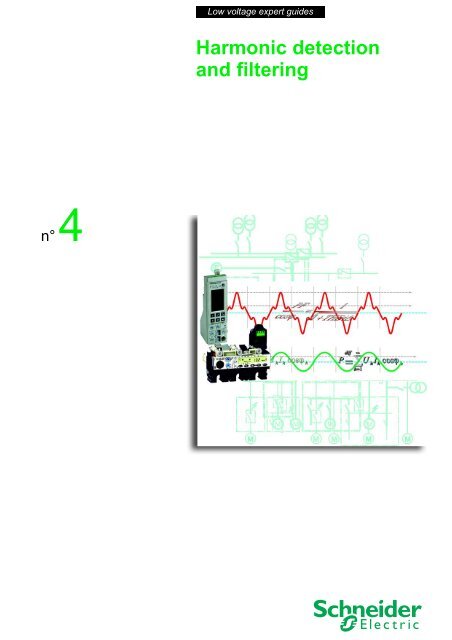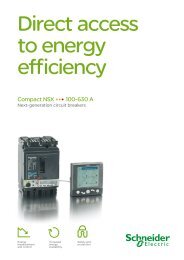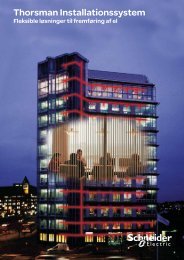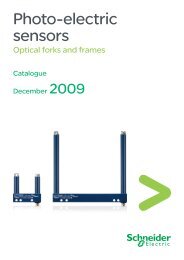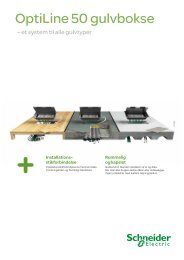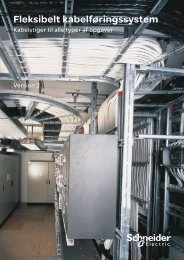Harmonic detection and filtering - Schneider Electric
Harmonic detection and filtering - Schneider Electric
Harmonic detection and filtering - Schneider Electric
Create successful ePaper yourself
Turn your PDF publications into a flip-book with our unique Google optimized e-Paper software.
Low voltage expert guides<strong>Harmonic</strong> <strong>detection</strong><strong>and</strong> <strong>filtering</strong>n° 4
Contents4.4 Disturbances to sensitive loads .......................................................264.4.1 Effects of supply-voltage distortion................................................................ 264.4.2 Disturbances on telephone lines ................................................................... 264.5 Economic consequences ................................................................264.5.1 Power losses ................................................................................................. 264.5.2 Additional subscribed power costs ................................................................ 264.5.3 Oversizing of equipment................................................................................ 264.5.4 Reduction in the service life of equipment..................................................... 274.5.5 Nuisance tripping <strong>and</strong> installation shutdown ................................................. 274.5.6 A few examples ............................................................................................. 275. St<strong>and</strong>ards <strong>and</strong> the regulatory environment .................... 285.1 Compatibility st<strong>and</strong>ards between distribution systems<strong>and</strong> products.................................................................................... 285.2 Distribution-system quality st<strong>and</strong>ards ..............................................285.3 St<strong>and</strong>ards on devices ......................................................................285.4 Maximum permissible harmonic values ..........................................295.5 Installation st<strong>and</strong>ards ......................................................................296. Solutions to attenuate harmonics .................................... 306.1 General solutions ............................................................................306.1.1 Positioning the disturbing loads upstream in the system............................... 306.1.2 Grouping the disturbing loads........................................................................ 306.1.3 Separating the sources.................................................................................. 316.1.4 Using transformers with special connections ................................................ 316.1.5 Installing inductors......................................................................................... 316.1.6 Selection of a suitable system earthing arrangement.................................... 326.2 Solutions when limit values are exceeded ......................................336.2.1 Passive filters ................................................................................................ 336.2.2 Active filters (active harmonic conditioners) .................................................. 336.2.3 Hybrid filters................................................................................................... 346.2.4 Selection criteria ............................................................................................ 357. <strong>Harmonic</strong>-<strong>detection</strong> devices from <strong>Schneider</strong> <strong>Electric</strong> ... 367.1 Detection .........................................................................................367.1.1 Built-in power meters..................................................................................... 367.1.2 External power meters................................................................................... 367.1.3 Using power-meter data ................................................................................ 377.2 Selection guide ................................................................................378. Product selection according to measurementfunctions ............................................................................. 389. <strong>Harmonic</strong>-management solutions from<strong>Schneider</strong> <strong>Electric</strong> .............................................................. 479.1 Analysis <strong>and</strong> diagnosis from <strong>Schneider</strong> <strong>Electric</strong> .............................489.2 Specific <strong>Schneider</strong> <strong>Electric</strong> products ...............................................499.2.1 Passive filters ................................................................................................ 499.2.2 Active filters of MGE UPS SYSTEMS ........................................................... 499.2.3 Hybrid filters................................................................................................... 499.3 Selection guide ................................................................................5010. Bibliography ....................................................................... 513
GeneralEn bref1.1 Definition of harmonics <strong>and</strong> their origin1.1.1 Distortion of a sinusoidal signal<strong>Harmonic</strong>s distort current <strong>and</strong>/orvoltage waves, disturbing theelectrical distribution system <strong>and</strong>degrading power quality.The Fourier theorem states that all non-sinusoidal periodic functions can berepresented as the sum of terms (i.e. a series) made up of:b a sinusoidal term at the fundamental frequencyb sinusoidal terms (harmonics) whose frequencies are whole multiples of thefundamental frequencyb a DC component, where applicable.The nth order harmonic (commonly referred to as simply the nth harmonic) in asignal is the sinusoidal component with a frequency that is n times the fundamentalfrequency.The equation for the harmonic expansion of a periodic function is presented below:n=∞y( t) = Yo + ∑Yn2 sin( nωt− ϕn)n=1where:b Yo: value of the DC component, generally zero <strong>and</strong> considered as such hereinafterb Yn: rms value of the nth harmonicb ω: angular frequency of the fundamental frequencyb ϕ n: displacement of the harmonic component at t = 0.Example of signals (current <strong>and</strong> voltage waves) on the French electrical distributionsystem:b the value of the fundamental frequency (or first order harmonic) is 50 hertz (Hz)b the second (order) harmonic has a frequency of 100 Hzb the third harmonic has a frequency of 150 Hzb the fourth harmonic has a frequency of 200 Hzb etc.A distorted signal is the sum of a number of superimposed harmonics.Figure 1 shows an example of a current wave affected by harmonic distortion.E95228Figure 1 - Example of a current containing harmonics <strong>and</strong> expansion of the overall current intoits harmonic orders 1 (fundamental), 3, 5, 7 <strong>and</strong> 9.5
GeneralRepresentation of harmonics: the frequency spectrumThe frequency spectrum is a practical graphical means of representing theharmonics contained in a periodic signal.The graph indicates the amplitude of each harmonic order.This type of representation is also referred to as spectral analysis.The frequency spectrum indicates which harmonics are present <strong>and</strong> their relativeimportance.Figure 2 shows the frequency spectrum of the signal presented in figure 1.E55523Figure 2 - Spectrum of a signal comprising a 50 Hz fundamental <strong>and</strong> harmonic orders 3 (150 Hz),5 (250 Hz), 7 (350 Hz) <strong>and</strong> 9 (450 Hz).1.1.2 Origin of harmonicsDevices causing harmonics are present in all industrial, commercial <strong>and</strong> residentialinstallations. <strong>Harmonic</strong>s are caused by non-linear loads.Definition of non-linear loadsA load is said to be non-linear when the current it draws does not have the samewave form as the supply voltage.Examples of non-linear loadsDevices comprising power electronics circuits are typical non-linear loads.Such loads are increasingly frequent <strong>and</strong> their percentage in overall electricalconsumption is growing steadily.Examples include:b industrial equipment (welding machines, arc furnaces, induction furnaces,rectifiers)b variable-speed drives for asynchronous <strong>and</strong> DC motorsb office equipment (PCs, photocopy machines, fax machines, etc.)b household appliances (television sets, microwave ovens, fluorescent lighting, etc.)b UPSs.Saturation of equipment (essentially transformers) may also cause non-linearcurrents.6
En bref<strong>Harmonic</strong> currents are caused bynon-linear loads connected to thedistribution system. The flow ofharmonic currents through systemimpedances in turn creates voltageharmonics, which distort the supplyvoltage.E95229Disturbances caused by non-linear loads, i.e. current <strong>and</strong>voltage harmonicsThe supply of power to non-linear loads causes the flow of harmonic currents in thedistribution system.Voltage harmonics are caused by the flow of harmonic currents through theimpedances of the supply circuits (e.g. transformer <strong>and</strong> distribution system a wholein figure 3).Figure 3 - Single-line diagram showing the impedance of the supply circuit for h-order harmonic.Note that the impedance of a conductor increases as a function of the frequency ofthe current flowing through it. For each h-order harmonic current, there is thereforean impedance Z h in the supply circuit.The h-order harmonic current creates via impedance Z h a harmonic voltage U h,where U h = Z h x I h, i.e. a simple application of Ohm’s law. The voltage at B is thereforedistorted <strong>and</strong> all devices supplied downstream of point B will receive a distortedvoltage.Distortion increases in step with the level of the impedances in the distributionsystem, for a given harmonic current.Flow of harmonics in distribution systemsTo better underst<strong>and</strong> harmonic currents, it may be useful to imagine that the nonlinearloads reinject harmonic currents upstream into the distribution system, in thedirection of the source.Figures 4a <strong>and</strong> 4b show an installation confronted with harmonic disturbances.Figure 4a shows the flow of the fundamental 50 Hz current, whereas in 4b, the h-order harmonic current is presented.E95230Figure 4a - Diagram of an installation supplying a non-linear load, showing only the fundamental50 Hz current.E95231Figure 4b - Diagram of the same installation, showing only the phenomena related to the h-orderharmonic.Supply of this non-linear load causes the flow in the distribution system of currentI 50Hz (shown in figure 4a) to which is added each of the harmonic currents I h (shownin figure 4b) corresponding to each harmonic (order h).7
GeneralUsing once again the model of non-linear loads reinjecting harmonic currents into thedistribution system, it is possible to graphically represent this phenomena(figure 5).E95232Figure 5 - Flow of harmonic currents in a distribution system.Note in this figure that certain loads cause harmonic currents in the distributionsystem <strong>and</strong> other loads are disturbed by them.8
1.2 Why harmonics need to be detected<strong>and</strong> suppressed ?1.2.1 Disturbances caused by harmonicsIn distribution systems, the flow of harmonics reduces power quality <strong>and</strong>consequently causes a number of problems:b overloads on distribution systems due to the increase in the rms currentb overloads on neutral conductors due to the summing of third-order harmonicscreated by single-phase loadsb overloads, vibrations <strong>and</strong> premature ageing of generators, transformers, motors,etc., transformer humb overloading <strong>and</strong> premature ageing of capacitors in power factor correctionequipmentb distortion of the supply voltage, capable of disturbing sensitive loadsb disturbances on communications networks <strong>and</strong> telephone lines.1.2.2 The economic impact of disturbances<strong>Harmonic</strong>s have a significant economic impact, in that:b premature ageing of equipment means that it must be replaced earlier, unless itwas oversized to begin withb overloads on the distribution system mean the level of subscribed power must beincreased, with additional losses, unless the installation can be upgradedb distortion of the current provokes nuisance tripping <strong>and</strong> shutdown of productionequipment.These extra costs in terms of equipment, energy <strong>and</strong> productivity all contributeto reducing the competitiveness of companies.1.2.3 Increasingly serious consequencesAs recently as ten years ago, harmonics were not considered a major problem,because their effects on distribution systems were, generally speaking, relativelyslight. However, the massive increase in the use of loads employing powerelectronics has significantly worsened the situation in all fields of activity.<strong>Harmonic</strong>s are all the more difficult to reduce in that they are often caused byequipment that is vital to the operation of companies.1.2.4 Practically speaking, which harmonics must bemeasured <strong>and</strong> reduced ?The harmonics most frequently encountered (<strong>and</strong> consequently the mosttroublesome) on three-phase distribution systems are the odd-order harmonics (3 rd ,5 th , 7 th , etc.).Beyond the 50 th order, harmonic currents are negligible <strong>and</strong> measurements are notrequired.Sufficient accuracy of measurements is obtained by taking into account harmonicsup to the 30 th order.Utilities monitor harmonic orders 3, 5, 7, 11 <strong>and</strong> 13.It follows that conditioning of harmonics is imperative up to order 13 <strong>and</strong> ideallyshould include harmonics up to order 25.9
En brefThe essential indicatorsof harmonic distortion<strong>and</strong> measurement principles2.1 Power factorThe power factor will be noted "PF" in this document.A number of indicators exist thatmay be used to quantify <strong>and</strong>assess the harmonic distortion ofcurrent <strong>and</strong> voltage waves.These indicators are:b the power factorb the crest factorb the distortion powerb the frequency spectrumb harmonic distortion.These indicators are indispensablein determining any corrective actionrequired.2.1.1 DefinitionThe power factor is the ratio between the active power P <strong>and</strong> the apparent power S.PFP=SIn electrical jargon, the power factor is often confused with cosine phi (cos ϕ), whichmay be defined by the equation:cosϕ = P S11P1 = active power of the fundamental.S1 = apparent power of the fundamental.As the above equation makes clear, cos ϕ applies only to the fundamental frequency.When harmonics are present, its value is different than that of the power factor.2.1.2 Interpreting the value of the power factorAn initial indication that significant harmonic distortion exists is provided when themeasured power factor is not equal to cos ϕ (i.e. the power factor is less than cos ϕ).2.2 Crest factor2.2.1 DefinitionThe crest factor is the ratio between the value of the peak current or voltage(I m or U m) <strong>and</strong> the corresponding rms value.kIm= or kIrmsU=UmrmsFor a sinusoidal signal, the crest factor is therefore equal to 2.For non-sinusoidal signals, the crest factor can be greater than or less than 2.This factor is particularly useful in drawing attention to exceptional peak values withrespect to the rms value.2.2.2 Interpreting the value of the crest factorA typical crest factor for the current drawn by non-linear loads is much greaterthan 2. Its value can range from 1.5 to 2 or even up to 5 in critical situations.A very high crest factor indicates that high overcurrents occur from time to time.These overcurrents, detected by the protection devices, may cause nuisancetripping.1010
2.3 Power <strong>and</strong> harmonics2.3.1 Active powerThe active power P of a signal distorted by harmonics is the sum of the activepowers corresponding to the voltages <strong>and</strong> currents in the same frequency order.The expansion of the voltage <strong>and</strong> current into their harmonic components may bewritten as:P =∞∑h=1U Icosϕh h hwhere ϕ h is the displacement between voltage <strong>and</strong> current of harmonic order h.Nota :b it is assumed that the signal does not contain a DC component, i.e. U 0= I 0 = 0b when the signal is not distorted by harmonics, the equation P = U 1 I 1 cos ϕ 1 againapplies, indicating the power of a sinusoidal signal, where cos ϕ 1 is equal to "cos ϕ").2.3.2 Reactive powerReactive power applies exclusively to the fundamental <strong>and</strong> is defined by theequation:Q=U 1. I 1.sinϕ12.3.3 Distorsion powerConsider the apparent power S:S = Urms.IrmsIn the presence of harmonics, the equation becomes:2 2 2S = ⎛ ∞UhIh⎝ ⎜ ⎞⎟ ⎛ ∞⎠ ⎝ ⎜⎞∑ . ∑ ⎟⎠n=4n=1Consequently, in the presence of harmonics, the equation S 2 =P 2 +Q 2 is no longervalid. The distortion power D is defined as S 2 =P 2 +Q 2 +D 2 , i.e.:2 2 2D= S −P −Q11
The essential indicatorsof harmonic distortion<strong>and</strong> measurement principles2.4 Frequency spectrum <strong>and</strong> harmoniccontent2.4.1 PrincipleEach device causing harmonics has its own harmonic-current "fingerprint", withdifferent amplitudes <strong>and</strong> displacements.These values, notably the amplitude of each harmonic order, are essential elementsfor analysis of harmonic distortion.2.4.2 Individual harmonic distortion (or harmonicdistortion of order h)Individual harmonic distortion is defined as the level of distortion, in percent,of order h, with respect to the fundamental:uhU(%) = 100Uh1orihI(%) = 100Ih12.4.3 Frequency spectrumBy plotting the amplitude of each harmonic order on a graph, we obtain a graphicalrepresentation of the frequency spectrum. This technique is referred to as spectralanalysis.Figure 6 shows the spectral analysis of a square-wave signal.E55530E55531Figure 6 - Spectral analysis of a square-wave signal, for voltage.2.4.4 RMS valueThe rms value of a current or voltage is calculated on the basis of the rms values ofthe various harmonic orders:IrmsUrms==∞∑I2hh=1∞∑U2hh=112
En bref2.5 Total harmonic distorsion (THD)2.5.1 Definition of total harmonic distortionTHD st<strong>and</strong>s for Total <strong>Harmonic</strong>Distortion.The level of harmonic distortion isoften used to define the degree ofharmonic content in an alternatingsignal.For a signal y, the total harmonic distortion (THD) is defined by the equation:THD =∞∑ y2hh=2y1This definition complies with that of st<strong>and</strong>ard IEC 61000-2-2.Note that the resulting value may exceed one.According to the st<strong>and</strong>ard, h can generally be limited to 50. This equation producesa single value indicating the distortion of a voltage or a current flowing at a given pointin a distribution system.<strong>Harmonic</strong> distortion is generally expressed as a percentage.2.5.2 Current <strong>and</strong> voltage THDWhen dealing with current harmonics, the equation becomes:THDI=∞∑I2hh=2I1The above equation is equivalent to the one below, which is more direct <strong>and</strong> easierto use when the total rms value is known:THDIIrms= ⎛ ⎝ ⎜ ⎞⎟ − 1I ⎠12When dealing with voltage harmonics, the equation becomes:THDu=∞∑ U2hh=2U12.5.3 particular case (thd)In certain countries with different work habits, a different equation is used to determineharmonic distortion. In this equation, the value of the fundamental voltage U1 or thefundamental current I1 is replaced by the rms values U rms <strong>and</strong> I rms respectively.To distinguish between the two equations, we will call the second the total harmonicfactor (thd).Example of a voltage thd:thdu=¥åU2hh = 2UeffThe thd, whether for voltage or current, is always less than 100 %. It makes analoguemeasurements of signals easier but is used less <strong>and</strong> less because the result is veryclose to the THD defined above when a signal is not significantly distorted. What ismore, it not well suited to highly distorted signals because it cannot exceed the valueof 100 %, contrary to the THD defined at the beginning of this section.13
The essential indicatorsof harmonic distortion<strong>and</strong> measurement principles2.5.4 Relation between power factor <strong>and</strong> THDWhen the voltage is sinusoidal or virtually sinusoidal, it may be said that:P# P = U . I .cosϕ1 1 1 1Consequently:P U . I .cosϕFP = #S U1.I rms1 1 1Where as:II1rms=11 + THD2IHence:FP#cosϕ 121 + THD IFigure 7 shows a graph of PF / cos ϕ as a function of THDi.PF / cos ϕ = f (THDi ).E55528Figure 7 - Variation of PF / cos ϕ as a function of THDi, where THDu = 0.14
En brefThe primary indicator is the THD, asingle value that reflects the level ofdistortion in voltage <strong>and</strong> currentwaves.The harmonic spectrum provides a"fingerprint" of the distorted signal.2.6 Usefulness of the various indicatorsb The voltage THD indicates the distortion of the voltage wave.The measured THDu can provide information on phenomena observed in theinstallation. A THDu value of less than 5 % is considered normal <strong>and</strong> there is virtuallyno risk of equipment malfunctions.A THDu value between 5 % <strong>and</strong> 8 % indicates significant harmonic distortion. Someequipment malfunctions may occur.A THDu value higher than 8 % indicates high harmonic distortion. Equipmentmalfunctions are probable. In-depth analysis is required <strong>and</strong> an attenuation systemmust be installed.b The current THD indicates the distortion of the current wave.To identify the load causing the disturbance, the current THD must be measured onthe incomer <strong>and</strong> the outgoers of the different circuits.The measured THDi can provide information on phenomena observed in theinstallation. A THDi value of less than 10 % is considered normal <strong>and</strong> there is virtuallyno risk of equipment malfunctions.A THDi value between 10 % <strong>and</strong> 50 % indicates significant harmonic distortion.Temperature rise may occur, which means cables <strong>and</strong> sources must be oversized.A THDi value higher than 50 % indicates high harmonic distortion. Equipmentmalfunctions are probable. In-depth analysis is required <strong>and</strong> an attenuation systemmust be installed.b The power factor PF indicates the extent to which the source of the installationmust be oversized.b The crest factor is used to determine the capacity of a generator (UPS orgenerator) to provide high instantaneous currents. For example, computers drawhighly distorted current with crest factors that may reach 3 or even 5.b The spectrum (signal broken down into frequency) provides a different view ofelectrical signals <strong>and</strong> may be used to assess distortion.15
Measuring the valuesof the indicators3.1 Measurement devices3.1.1 Selection of a measurement deviceOnly digital analysers, based on recent technology, provide sufficiently accuratemeasurements for the indicators presented above.Other measurement devices were used in the past.b oscilloscopes for observation purposesA general indication of the distortion of a signal may be obtained by viewing thecurrent or the voltage on an oscilloscope.When the wave form is not sinusoidal, the signal is distorted by harmonics. Thevoltage <strong>and</strong> current peaks can be displayed.Note that using an oscilloscope, it is not possible to precisely quantify the harmoniccomponents.b analogue spectral analysersImplementing old technology, these devices are made up of a passb<strong>and</strong> filtercombined with an rms voltmeter.These devices, now outdated, produce mediocre results <strong>and</strong> do not provide anyinformation on displacement.3.1.2 Functions of digital analysersThe microprocessors used in digital analysers:b calculate the values of the harmonic indicators (power factor, crest factor,distortion power, THD)b offer a number of additional functions (correction, statistical <strong>detection</strong>,management of measurements, display, communication, etc.)b when they are multi-channel devices, provide simultaneously <strong>and</strong> nearly in realtime the spectral breakdown of voltage <strong>and</strong> current.3.1.3 Operating principle of digital analysers <strong>and</strong>data-processing techniquesAnalogue signals are converted into a series of digital values.On the basis of the digital values, an algorithm implementing the Fast FourierTransform (FFT) calculates the amplitude <strong>and</strong> the phases of the harmonics overa large number of observation time windows.Most digital analysers measure harmonics up to the 20 th or 25 th order for calculationof the THD.Processing of the various values calculated using the FFT algorithm (smoothing,classification, statistics) can be carried out by the measurement device or by externalsoftware.16
3.2 Procedure for harmonic analysis of adistribution systemMeasurements are carried out on industrial <strong>and</strong> commercial sites as a:b preventive measure:v to obtain an overall assessment of the extent of the problem (map of thedistribution system)b remedial measure:v to determine the origin of a disturbance <strong>and</strong> devise solutions to correct theproblemv to check that the solutions implemented actually produced the desiredeffect.Operating modeVoltage <strong>and</strong> current measurements must be carried out:b at the power sourceb on the incoming busbars of the main distribution switchboardb on each of the outgoers leaving the main distribution switchboard.When the measurements are carried out, it is necessary to have precise informationon the conditions, in particular the status of capacitor banks (ON or OFF, number ofstages connected).On the basis of analysis results, it may be necessary to:b derate any future equipment installedorb quantify the protection <strong>and</strong> harmonic-<strong>filtering</strong> solutions that must be installedb compare the values measured to the reference values of the utility (harmonicdistortionlimits, acceptable values, reference values).Use of measurement devicesThe devices show both the instantaneous effects <strong>and</strong> the long-term effects ofharmonics.Correct analysis requires integrated values over time spans ranging from a fewseconds to a few minutes, for observation periods of a few days.The required values are:b the amplitude of voltage <strong>and</strong> current harmonicsb the individual harmonic distortion of each order, for both current <strong>and</strong> voltageb total harmonic distortion for both current <strong>and</strong> voltageb where applicable, the displacement between voltage <strong>and</strong> current harmonics of thesame order <strong>and</strong> the phase of the harmonics with respect to a common reference (thefundamental voltage, for example).17
Measuring the valuesof the indicators3.3 Anticipating harmonic conditioningneedsThe harmonic indicators can be measured:b by permanently installed devicesb by an expert present at least a half-day on the site (for a view limited in time).3.3.1 The advantages of permanently installeddevicesFor a number of reasons, it is preferable to use devices installed permanently in thedistribution system.b a visit by an expert is necessarily limited in time, whereas measurements atdifferent points in the installation over a sufficiently long period (one week to onemonth) provide an overall view of system operation <strong>and</strong> cover all the situations thatmay arise following:v fluctuation of the power sourcev variations in system operationv installation of new equipmentb measurement devices installed in the distribution system prepare <strong>and</strong> facilitatetroubleshooting by experts, thus reducing the number <strong>and</strong> duration of their visitsb permanently installed measurement devices detect any new disturbancescaused by the installation of new equipment, by new operating modes or byfluctuations on the distribution system.3.3.2 The advantages of integrated measurement<strong>and</strong> <strong>detection</strong> devicesMeasurement <strong>and</strong> <strong>detection</strong> devices that are built into the electrical distributionequipment offer a number of advantages.b for an overall assessment of the distribution system (preventive measure),they avoid:v renting the measurement devicesv hiring the services of expertsv having to connect <strong>and</strong> disconnect all the measurement devices.In an overall assessment of the distribution system, an analysis at the main lowvoltageswitchboard level can commonly be carried out by the incoming device <strong>and</strong>/or the measurement devices built into each outgoing device.b for an assessment in view of remedial action, they:v indicate the operating conditions when the incident occurredv provide a "map" of the installation <strong>and</strong> indications on the selected solution.A full diagnosis will often also require additional information provided by specificequipment suited to the problem at h<strong>and</strong>.18
The main effects of harmonicsin installationsEn bref<strong>Harmonic</strong>s have a major economicimpact on installations in that theycause:b higher energy billsb premature ageing of equipmentb drops in productivity.4.1 ResonanceThe use of both capacitive <strong>and</strong> inductive devices in distribution systems leads toresonance phenomena, resulting in extremely high or low impedance values. Thesevariations in impedance modify the current <strong>and</strong> voltage in the distribution system.Here we will discuss only parallel-resonance phenomena, which are the mostfrequent.Consider the simplified diagram below, showing an installation made up of:b a transformer supplying powerb linear loadsb non-linear loads causing harmonic currentsb power factor correction capacitors.E95233For harmonic-analysis purposes, the equivalent diagram is shown below:E56976Ls: supply inductance (distributionsystem + transformer + line)C: power factor correction capacitanceR: resistance of the linear loadsIh: harmonic currentjLsωZ =1 − LCωs2when R is neglected.Resonance occurs when the denominator 1-LsCw 2 approaches zero. Thecorresponding frequency is called the resonant frequency of the circuit. At thisfrequency, the impedance is at its maximum value, resulting in considerable voltageharmonics <strong>and</strong> consequently major voltage distortion. This voltage distortion isaccompanied by the circulation of harmonic currents in the Ls + C circuit which aregreater than the injected harmonic currents.The distribution system <strong>and</strong> the power factor correction capacitors are subjected toconsiderable harmonic currents, resulting in the risk of overloads.19
The main effects of harmonicsin installations4.2 Increased losses4.2.1 Losses in conductorsThe active power transmitted to a load depends on the fundamental current. Whenthe current drawn by the load contains harmonics, the rms value of the currentis greater than the fundamental I 1 .I rmsWith THD defined as:IrmsTHD = ⎛ ⎝ ⎜ ⎞⎟ − 1I ⎠it may be deduced that:I = rmsI + 11 THD122Figure 8 below shows, as a function of the harmonic distortion:b the increase in the rms current (I rms) for a load drawing a given fundamental currentb the increase in the Joule losses (P Joules), without taking into account the skin effect.(The reference point for Irms <strong>and</strong> P Joules with no harmonics is set to 1 on the graph).E55532Figure 8 - Increase in rms current <strong>and</strong> Joule losses as a function of THD.Current harmonics provoke an increase in Joule losses in all the conductors throughwhich they flow <strong>and</strong> additional temperature rise in the transformers, circuit breakers,cables, etc.20
4.2.2 Losses in asynchronous machinesVoltage harmonics, when applied to asynchronous machines, provoke the flow ofcurrents with frequencies higher than 50 Hz in the rotor. These currents causeadditional losses that are proportional to Uh 2 /h.b estimating the losses:v a virtually square-wave supply voltage provokes a 20 % increase in lossesv a supply voltage with the following levels of individual harmonic distortion (u h)where U 1 is the fundamental voltage:-u 5: 8 % of U 1-u 7: 5 % of U 1-u 11: 3 % of U 1-u 13: 1 % of U 1(i.e. a voltage THD of 10 %) results in additional losses of 6 %.4.2.3 Losses in transformers<strong>Harmonic</strong> currents flowing in transformers provoke increased losses in the windingsthrough the Joule effect <strong>and</strong> increased iron losses due to eddy currents.What is more, voltage harmonics cause iron losses due to hysterisis.Roughly speaking, it may be said that the losses in the windings increase as thesquare of the current THD, <strong>and</strong> losses in the core increase linearly with the voltageTHD.b estimating the losses:v the increase in losses represents 10 % to 15 % for public-distributiontransformers, where distortion levels relatively low.4.2.4 Losses in capacitors<strong>Harmonic</strong> voltage, when applied to capacitors, provokes the flow of currents that areproportional to the frequency of the harmonics. These currents cause additionallosses.b example:consider a supply voltage with the following levels of individual harmonic distortion(u h) where U 1 is the fundamental voltage:-u 5: 8 % of U 1-u 7: 5 % of U 1-u 11: 3 % of U 1-u 13: 1 % of U 1(i.e. a voltage THD of 10 %).IIIIIII1571113I= U1.C.ω= U 5.C.5.ω = u5.5.I1= U 7.C.7.ω = u7.7.I1= U 11.C.11.ω = u11.11.I1= U13.C.13.ω = u13.13. I1rmsrms1==∑I2h1 + ( u52.5 ) + ( u72.7) + ( u11.11)2+ ( u13.13)2= 1,19In this example, Joule losses are multiplied by 1.19 2 = 1.4.21
The main effects of harmonicsin installations4.3 Overloads on installation equipment4.3.1 GeneratorsGenerators supplying non-linear loads must be derated due to the additional lossescaused by the harmonic currents. The derating coefficient is approximately 10 %for a generator supplying a set of loads in which 30 % are non-linear loads. As aresult, the generator must be oversized.4.3.2 UPSsThe current drawn by computer equipment has a high crest factor. A UPS sizedtaking into account only the rms current value may not be capable of supplying therequired peak current <strong>and</strong> thus be overloaded.4.3.3 Transformersb the curve in figure 9 below shows typical derating values for a transformersupplying electronic (i.e. non-linear) loads.Example: a transformer supplying loads that are 40 % electronic must be derated40 %.E95234Figure 9 - Derating values for a transformer supplying electronic loads.22
st<strong>and</strong>ard UTE C15-112 indicates a derating factor for transformers calculated as afunction of the harmonic currents:k =T= hhI 11⎛1+0,1. ⎜⎝I40∑h=21 ,6.T2⎞h ⎟⎠typical values:v "square-wave" current (spectrum inversely proportional to h (1) ): k = 0.86v current drawn by a frequency converter (THD ≈ 50 %): k = 0.80.(1) in fact, the current wave form is approximately that of a square wave form. This is the casefor all current rectifiers (three-phase rectifiers, induction furnaces, etc.).b "K factor":St<strong>and</strong>ard ANSI C57.110 defines a derating method based on the "K factor", with theequation below.∞∑2 2Ih.hh=1K =∞=2I∑h=1hThe K factor produces more severe derating <strong>and</strong> is widely used in North America.In the example presented below, the resulting "K factor" is 13.Order h I h (%)5 307 2011 1413 1117 819 723 525 4h∞∑h=1⎛ I⎜⎝ Ihrms2⎞⎟ . h⎠2The increase in cost for a transformer sized using the "K factor" varies from 30 % to60 % depending on the rating, in a range from 15 to 500 kVA.4.3.4 Asynchronous machinesb st<strong>and</strong>ard IEC 60892 defines a weighted harmonic voltage factor (HVF) for whichthe equation <strong>and</strong> the maximum permissible value are presented below:13UhHVF = ∑∆ ≤2hh=2002 ,b example:consider a supply voltage with the following levels of individual harmonic distortion(u h) where U 1 is the fundamental voltage:-u 3 : 2 % of U 1-u 5 : 3 % of U 1-u 7 : 1 % of U 1(i.e. a voltage THD of 3.7 % <strong>and</strong> a HVF of 0.018).In this example, the harmonic voltage factor is very close to the maximum value atwhich the machine must be derated.Practically speaking, an asynchronous machine must not be supplied with powerhaving a THDu greater than 10 %.23
The main effects of harmonicsin installations4.3.5 CapacitorsAccording to st<strong>and</strong>ards, the rms current flowing in capacitors must not exceed 1.3times the rated current.b example (already presented above):consider a supply voltage with the following levels of individual harmonic distortion(u h) where U 1 is the fundamental voltage:-u 5 : 8 % of U 1-u 7 : 5 % of U 1-u 11 : 3 % of U 1-u 13 : 1 % of U 1(i.e. a voltage THD of 10 %).as a resultIIrms1= 119 ,, at the rated voltage.At a voltage level equal to 1.1 times the rated voltage,II1current level is overrun <strong>and</strong> the capacitors must be resized.rms= 13 ,the maximum4.3.6 Neutral conductorsConsider a system made up of a balanced three-phase source <strong>and</strong> three identicalsingle-phase loads connected phase-to-neutral.E95235Figure 10 - Flow of currents in the various conductors connected to a three-phase source.24
The graphs in figure 11 below show an example of the currents flowing in the threephases <strong>and</strong> the resulting current in the neutral conductor.E55536E55535Figure 11 - Example of currents flowing in the various conductors connected to a three-phaseload, where I n = i r + i s + i t.In this example, the rms value of the current in the neutral conductor is 3 timesgreater than that of the current in a phase. The neutral conductor must therefore beresized accordingly.25
The main effects of harmonicsin installations4.4 Disturbances to sensitive loads4.4.1 Effects of supply-voltage distortionb distortion of the supply voltage may disturb operation of sensitive loads, including:v regulation systems (temperature, etc.)v computer equipmentv control <strong>and</strong> monitoring systems (protection relays).4.4.2 Disturbances on telephone lines<strong>Harmonic</strong>s can induce disturbances in circuits conducting low currents. The degreeof disturbance depends on the distance over which the power <strong>and</strong> signal lines run inparallel, the distance between the lines <strong>and</strong> the frequency of the harmonics.4.5 Economic consequences4.5.1 Power lossesThe Joule effect, induced by harmonic currents in the conductors <strong>and</strong> equipment,causes additional power losses.4.5.2 Additional subscribed power costsThe presence of harmonic currents makes it necessary to increase the subscribedpower level <strong>and</strong>, consequently, the cost of the subscription.What is more, utilities will be increasingly inclined in the future to transfer costs to theproducers of harmonic disturbances.4.5.3 Oversizing of equipmentb derating of power sources (generators, transformers <strong>and</strong> UPSs) means they mustbe oversizedb conductors must be sized taking into account the flow of harmonic currents.Because the frequencies of the harmonics are higher than that of the fundamental,the impedances encountered by these currents are higher. To avoid excessive lossesdue to the Joule effect, the conductors must be oversizedb the circulation of harmonic currents in the neutral conductor means the conductormust be oversized.26
4.5.4 Reduction in the service life of equipment(Data obtained from the Canadian <strong>Electric</strong>al Association).When distortion of the supply voltage is in the 10 % range, equipment service life issignificantly reduced. Depending on the type of device, the reduction in service lifemay be estimated at:b 32.5 % for single-phase machinesb 18 % for three-phase machinesb 5 % for transformers.To maintain the service life observed with a normal supply voltage, devices must beoversized.4.5.5 Nuisance tripping <strong>and</strong> installation shutdownInstallation circuit breakers are subjected to current peaks caused by harmonics.These current peaks cause nuisance tripping <strong>and</strong> result in production losses as wellas costs corresponding to the time required to put the installation back into runningorder.4.5.6 A few examplesFor the installations in the examples below, the significant economic consequencesmade necessary the use of harmonic filters.b computer centre of an insurance company:in this computer centre, nuisance tripping of a circuit breaker caused a loss estimatedat 100 000 euros per hour of down timeb pharmaceutical laboratory:harmonics provoked the failure of an engine generator set <strong>and</strong> interruption of a verylengthy test phase on a new product. The estimated loss amounted to 17 millioneurosb metallurgy factory:induction furnaces provoked overloads causing irreversible damage to threetransformers ranging from 1500 to 2500 kVA in one year, <strong>and</strong> production lossesestimated at 20 000 euros per hourb garden-furniture factory:failure of variable-speed drives provoked production losses estimated at 10 000euros per hour.27
St<strong>and</strong>ards <strong>and</strong> the regulatoryenvironmentEn brefIn order to rapidly reduce the effects of harmonic disturbances, a three-part systemof st<strong>and</strong>ards <strong>and</strong> regulations is now in force. This system is presented below.<strong>Harmonic</strong> levels are governed by aseries of st<strong>and</strong>ards <strong>and</strong> regulations:b compatibility st<strong>and</strong>ards fordistribution systemsb st<strong>and</strong>ards setting limit values fordevices causing harmonicsb recommendations issued byutilities <strong>and</strong> applicable toinstallations.5.1 Compatibility st<strong>and</strong>ards betweendistribution systems <strong>and</strong> productsThese st<strong>and</strong>ards stipulate a number of criteria concerning compatibility betweendistribution systems <strong>and</strong> products, such that:b the harmonic disturbances caused by a device in the system must not exceed theset limitsb each device must be capable of operating normally in the presence ofdisturbances at least equal to the set limitsb IEC 1000-2-2 for low-voltage public distribution systemsb IEC 1000-2-4 for low-voltage <strong>and</strong> medium-voltage industrial installations.5.2 Distribution-system quality st<strong>and</strong>ardsb st<strong>and</strong>ard EN 50160 stipulates the characteristics of the voltage supplied by lowvoltagepublic distribution systemsb st<strong>and</strong>ard IEEE 519 (Recommended practices for harmonic control in electricalpower systems) is a joint approach between utilities <strong>and</strong> their customers to limit theimpact of non-linear loads.What is more, utilities encourage preventive action to limit the impact on the qualityof electricity, temperature rise <strong>and</strong> reductions in the power factor. They are alsoconsidering applying financial penalties to those customers producing disturbances.5.3 St<strong>and</strong>ards on devicesb IEC 61000-3-2 ou EN 61000-3-2 for low-voltage devices drawing less than 16 Ab IEC 61000-3-4 or EN 61000-3-4 for low-voltage devices drawing more than 16 A.2828
5.4 Maximum permissible harmonic valuesOn the basis of data drawn from a number of international studies, it was possible toestimate the typical harmonic values encountered in distribution systems.Formulated on the basis of work carried out by the CIGRE organisation, the tablebelow reflects the opinion of a large number of utilities concerning harmonic limitsthat should not be exceeded.Odd harmonics, non-multiples of 3 Odd harmonics, multiples of 3 Even harmonicsOrder h LV MV VHV Order h LV MV VHV Order h LV MV VHV5 6 6 2 3 5 2.5 1.5 2 2 1.5 1.57 5 5 2 9 1.5 1.5 1 4 1 1 111 3.5 3.5 1.5 15 0.3 0.3 0.3 6 0.5 0.5 0.513 3 3 1.5 21 0.2 0.2 0.2 8 0.5 0.2 0.217 2 2 1 > 21 0.2 0.2 0.2 10 0.5 0.2 0.219 1.5 1.5 1 12 0.2 0.2 0.223 1.5 1 0.7 > 12 0.2 0.2 0.225 1.5 1 0.7> 25 0.2 + 25h 0.2 + 25h 0.1 + 25h5.5 Installation st<strong>and</strong>ardsThe impact of the THD value on the safety of equipement has led the installationst<strong>and</strong>ards to impose thresholds in determining their capactity to be detrimental.Therefore the French installation st<strong>and</strong>ard NF C 15-100 imposes the choice ofneutral conductors cross section according to the thresholds of 15 %, 33 % <strong>and</strong> 45 %of the level of rank 3 harmonics in the phase current (§ 524.2):S N = 1/2 S PhS N = S PhS N > SPhTHDI H3 y 15 % 15 % < THDI H3 y 33 % THDI H3 > 33 %PermittedProhibitedProhibitedNeutral protectioncompulsoryPermittedNeutral protectionoptionalPermittedCurrent in the phasesdetermines the crosssection of allconductorsPermittedThe current in theneutral determines thecross section of all theconductorsPermittedThe current in theneutral onlydetermines the crosssection of the neutralIn this case, <strong>Schneider</strong> <strong>Electric</strong> proposes special trip units (OSN trip units) whichallow using a cross section of phase conductors smaller than the neutral conductorcross section, in the case of large THDI H3.<strong>Harmonic</strong> three in the phasecurrent (%)Reduction factorChoice based on the phasecurrent0 - 15 1.0 -15 - 33 0.86 -33 - 45 - 0.86> 45 - 1.0Choice based on the neutralcurrent29
Solutions to attenuate harmonicsEn bref6.1 General solutionsTo limit the propagation of harmonics in the distribution system, a number ofmeasures may be taken, particularly when designing a new installation.There are three different types ofsolutions that may be used toattenuate the effects of harmonics:b modifications to the installationb use of special devices in the powersupply system (inductors, specialtransformers)b filters.6.1.1 Positioning the disturbing loads upstreamin the systemThe overall level of harmonic disturbance increases as the short-circuit powerdecreases.Economic considerations aside, it is therefore preferable to connect the disturbingloads as far upstream as possible (see figure 12a).E95236Figure 12a - Supply of non-linear loads as far upstream as possible (recommended diagram).6.1.2 Grouping the disturbing loadsWhen preparing the single-line diagram, separate where possible the disturbingequipment from the other loads (see figure 12b). Practically speaking, the differenttypes of loads should be supplied by different busbars.By grouping the disturbing loads, the possibilities of angular recomposition areincreased. The reason is that the vector sum of the harmonic currents is lower thantheir algebraic sum.An effort should also be made to avoid the flow of harmonic currents in the cables,thus limiting voltage drops <strong>and</strong> temperature rise in the cables.E95237Figure 12b - Grouping of non-linear loads <strong>and</strong> supply as far upstream as possible(recommended diagram).3030
6.1.3 Separating the sourcesIn efforts to attenuate harmonics, an additional improvement may be obtained bysupplying the different loads via different transformers, as indicated in the simplifieddiagram below (figure 13).E95238Figure 13 - Supply of the disturbing loads via a separate transformer.This disadvantage of this solution is the increase in the cost of the installation.6.1.4 Using transformers with special connectionsSpecial types of connection may be used in transformers to eliminate certainharmonic orders.The harmonic orders eliminated depend on the type of connection implemented:b a delta-star-delta connection eliminates harmonic orders 5 <strong>and</strong> 7 (see figure 14)b a delta-star connection eliminates harmonic order 3 (the harmonics flow in each ofthe phases <strong>and</strong> loop back via the transformer neutral)b a delta-zigzag 5 connection eliminates harmonic order 5 (loop back via themagnetic circuit).E55543Figure 14 - A delta-star-delta transformer prevents propagation of harmonic orders 5 <strong>and</strong> 7upstream in the distribution system.6.1.5 Installing inductorsIn installations comprising variable-speed drives, the current can be smoothed byinstalling line inductors. By increasing the impedance of the supply circuit, theharmonic current is limited.Use of harmonic inductors on capacitor banks is a means of increasing theimpedance of the inductor <strong>and</strong> capacitor assembly, for harmonics with highfrequencies.31
Solutions to attenuate harmonics6.1.6 Selection of a suitable system earthingarrangementb TNC systemIn TNC systems, a single conductor, the PEN, ensures protection in the event of anearth fault <strong>and</strong> carries imbalance currents.Under steady-state conditions, the harmonic currents flow through the PEN.However, the PEN has a certain impedance, resulting in slight voltage differences (afew volts) between devices which may lead to malfunctions of electronic equipment.The TNC system must therefore be used only for the supply of power circuits on theupstream end of installations <strong>and</strong> must never be used for the supply of sensitiveloadsb TNS systemThis system is recommended when harmonics are present.The neutral conductor <strong>and</strong> the protection conductor PE are completely separate,thus ensuring a much more stable voltage on the distribution system.32
En brefIn cases where the preventivemeasures presented above are notsufficient, the installation must beequipped with filters.There are three types of filters:b passive filtersb active filtersb hybrid filters.6.2 Solutions when limit values areexceeded6.2.1 Passive filtersb typical applications:v industrial installations comprising a set of devices causing harmonics with a totalpower rating greater than approximately 200 kVA (variable-speed drives, UPSs,rectifiers, etc.)v installations where power factor correction is requiredv situations where voltage distortion must be reduced to avoid disturbing sensitiveloadsv situations where current distortion must be reduced to avoid overloadsb operating principle:an LC circuit, tuned to each of the harmonic frequencies requiring <strong>filtering</strong>, is installedin parallel with the device causing the harmonic distortion (see figure 15).This bypass circuit draws the harmonics, thus avoiding the flow of harmonics to thepower source.E95239Figure 15 - Operating principle of a passive filter.Generally speaking, the passive filter is tuned to a harmonic order near the one to beeliminated. A number of parallel-connected filters may be used when a significantreduction in distortion over a range of orders is required.6.2.2 Active filters (active harmonic conditioners)b typical applications:v commercial installations comprising a set of devices causing harmonics with atotal power rating less than 200 kVA (variable-speed drives, UPSs, office equipment,etc.)v situations where current distortion must be reduced to avoid overloadsb operating principle:active filters are systems employing power electronics, installed in series or in parallelwith the non-linear load, to provide the harmonic currents required by non-linearloads <strong>and</strong> thereby avoid distortion on the power system.33
Solutions to attenuate harmonicsFigure 16 shows an example of an active filter compensating the harmonic current(I har = -I act).E95240Figure 16 - Operating principle of an active filter.The active filter injects, in opposite phase, the harmonics drawn by the load, suchthat the line current Is remains sinusoidal.6.2.3 Hybrid filtersb typical applications:v industrial installations comprising a set of devices causing harmonics with a totalpower rating greater than 200 kVA approximately (variable-speed drives, UPSs,rectifiers, etc.)v installations where power factor correction is requiredv situations where voltage distortion must be reduced to avoid disturbing sensitiveloadsv situations where current distortion must be reduced to avoid overloadsv situations where conformity with strict harmonic-emission limits is requiredb operating principle:the two types of filters presented above can be combined in a single device, thusconstituting a hybrid filter (see figure 17). This new <strong>filtering</strong> solution combines theadvantages of the existing systems <strong>and</strong> provides a high-performance solutioncovering a wide power range.E95241Figure 17 - Operating principle of a hybrid filter.34
6.2.4 Selection criteriab passive filters offer both:v power factor correctionv large capacity for current <strong>filtering</strong>.Installations where passive filters are installed must be sufficiently stable, i.e. a lowlevel of load fluctuations.If a high level of reactive power is supplied, it is advised to de-energise the passivefilter when load levels are low.Preliminary studies for a filter must take into account any capacitor banks <strong>and</strong> maylead to their elimination.b active harmonic conditioners compensate harmonics over a wide range offrequencies. They can adapt to any load, however, their conditioning capacity islimitedb hybrid filters combine the strong points of both passive filters <strong>and</strong> active harmonicconditioners.35
<strong>Harmonic</strong>-<strong>detection</strong> devicesfrom <strong>Schneider</strong> <strong>Electric</strong>En bref7.1 Detection<strong>Harmonic</strong> pollution control mainly requires measurement. According to eachinstallation various kinds of <strong>Schneider</strong> <strong>Electric</strong> equipment provide a solution.DB10509262111-48-M056404-30-MDB117446-35<strong>Schneider</strong> <strong>Electric</strong> offers a completerange of harmonic-distortion<strong>detection</strong> devices:b Powerlogic (Power Meter <strong>and</strong>Circuit Monitor)b Micrologic.Power Meter PM800.Circuit Monitor Series 3000.Micrologic H control unit integrated into the NW <strong>and</strong> NTMasterpact circuit breakers.Micrologic E trip unit integrated into Compact NSX circuitbreakers.7.1.1 Built-in power metersMicrologic: a power meter built into circuit breakersThe Micrologic control unit equips Masterpact power circuit breakers (Micrologic H)<strong>and</strong> Compact NSX moulded case circuit breakers (Micrologic 5/6 A/E).The Micrologic control unit provides in-depth analysis of power quality <strong>and</strong> detaileddiagnosis of events. The data provided by Micrologic is intended for use on aswitchboard display unit or a supervisor.It provides:b measurement of currents, voltages, active <strong>and</strong> reactive powerb measurement of the current <strong>and</strong> voltage THDb display of the current <strong>and</strong> voltage harmonic components (amplitude <strong>and</strong> phase upto the 31th order)b recording of wave forms (waveform capture).A switchboard display (FDM 121) allows us to increase display <strong>and</strong> readingergonomics of electrical parameters.7.1.2 External power metersPower Meter <strong>and</strong> Circuit Monitor of PowerLogic SystemPowerlogic products are high-performance analysis tools for medium- <strong>and</strong> lowvoltage distribution systems. They are digital power meters designed to measurepower quality.The Powerlogic range is made up of Power Meters (PM), Circuit Monitors (CM) <strong>and</strong>ION devices. This highly modular range provides solutions for very simple needs,covered by the PMs, up to the most complex, covered by the CMs. These productsare used in new or existing installations where a high level of power quality ism<strong>and</strong>atory. They may be operated both locally <strong>and</strong> remotely.Depending on their position in the installation, Power Meters offer an initial estimationof power quality. The main measurements carried out by PMs are the:b current <strong>and</strong> voltage THDb power factor.Depending on the model in the range, these functions may be combined withtimestamping <strong>and</strong> alarms.CM <strong>and</strong> PM850 provide in-depth analysis of power quality <strong>and</strong> system disturbances.The main CM functions are:b measurement of over 100 electrical parametersb storage in memory <strong>and</strong> time stamping of the minimum <strong>and</strong> maximum values foreach electrical parameterb alarm tripping by electrical parametersb event loggingb recording of current <strong>and</strong> voltage disturbancesb harmonic analysisb recording of wave forms (waveform capture)b st<strong>and</strong>ard EN50160 indicators (CM4000 <strong>and</strong> 4000T only).3636
E95389DB1051547.1.3 Using power-meter dataRemote management <strong>and</strong> analysis softwareIn the wider framework of an entire distribution system that must be monitored,<strong>Schneider</strong> <strong>Electric</strong> offers the communications systems required to interconnect allthe various devices via a network, thus making it possible to centralise information<strong>and</strong> obtain an overall view of disturbances over the entire distribution system.Depending on the devices <strong>and</strong> software used, it is possible to carry outmeasurements in real time, calculate averages, record wave forms, anticipate onalarms, etc.The power meters transmit all the accessible data via ModBus.The primary purpose of these systems is to assist in identifying <strong>and</strong> planningmaintenance work. They can significantly reduce servicing times <strong>and</strong> installationcosts for temporary devices used for on-site measurements or for sizing ofequipment (filters).<strong>Schneider</strong> <strong>Electric</strong> offers one supervision-software product <strong>and</strong> Web pages.SMSSMS is a very complete software system for analysis of distribution systems, used inconjunction with Powerlogic products.Installed on a st<strong>and</strong>ard PC, it can be used to:b view measurements on a real time basisb view histories, over a set periodb select the manner in which data is displayed (tables, various curves)b process statistical data (display of histograms).Web pages (EN 50160) for CM 4000-4000 T only, with ECC Card.HTML format summarising <strong>and</strong> diagnosis pages concerning st<strong>and</strong>ard EN 50160indicators can be downloaded on the Ethernet ECC card,to use all these data directlywith a st<strong>and</strong>ard Web application (e.g. Internet Explorer).7.2 Selection guideThe table below presents the most suitable applications of the various devices forharmonic measurements:Goal of <strong>detection</strong> PM500 to PM820 Micrologic E Micrologic H PM850/CM3000/4000Overall evaluation of distribution-system status b b b b b b b b b b b bPrecise diagnosis b b b b b b b b b bAnalysis b b b b b b b bAdvantagesKey:b b b : perfectly suitedb b : satisfactoryb : Manque légendeBasic measurements,easy to use, inexpensive,small size <strong>and</strong> highaccuracyDB117442FunctionsBuilt into the mouldedcasecircuit breaker,allows monitoring ofinstallation <strong>and</strong> providesmeasurement of morethan 100 electricalparameters withoutexternal CT.Built into the circuitbreaker,allowsmonitoring at the supplyend of the installation oron large feeders withoutadditional cabling or CT +on-board non volatilealarm.Very complete, highlyaccurate measurementdevice, large datastoragecapacity,programmable fastmeasurementsAnalysisSMSDiagnosticsPM700-700P-710 PM800 PM820-850(PowerLogic) Micrologic H(Masterpact)CM3000-4000(PowerLogic)DetectionPM500PM700-700P-710PM800-820-850(PowerLogic)Micrologic E(Compact NSX)Figure 18 - Relative positions of the various <strong>detection</strong> products.37
Product selection according tomeasurement functionsPower MeterPM9P/PM9C PM500 PM700 PM700P PM710 PM810 PM820 PM850General selection criteriaInstallation On DIN rail Flush mount Flush mount Flush mountUse on LV distribution systems b b b b b b b bUse on LV <strong>and</strong> HV distribution systems - b b b b b b bCurrent / voltage accuracy 0.5 % 0.5 % 0.5 % 0.5 % 0.5 % 0.1 % 0.1 % 0.1 %Power / energy accuracy 2 % 1 % 1 % 1 % 1 % 1 % 0.5 % 0.5 %Instantaneous rms valuesCurrent b Phases b b b b b b b bb Neutral b b b b b b b bb Extended measurement range - - - - - - - -Voltage Phase-to-phase <strong>and</strong> phase-to-neutral b b b b b b b bFrequency b b b b b b b bTotal power b Active b b b b b b b bb Reactive b b b b b b b bb Apparent b b b b b b b bPower per phase b Active b b b b b b b bb Reactive b b b b b b b bb Apparent - b b b b b b bPower factor b Total b b b b b b b bb Per phase - b - - - b b bEnergy valuesActive energy b b b b b b b bReactive energy b b b b b b b bApparent energy - b b b b b b bUser-set accumulation mode - - - - - b b bDem<strong>and</strong> valuesCurrent Present <strong>and</strong> maximum values - b b b b b b bTotal active power Present <strong>and</strong> maximum values b b b b b b b bTotal reactive power Present <strong>and</strong> maximum values - b b b b b b bTotal apparent power Present <strong>and</strong> maximum values - b b b b b b bTotal predicted dem<strong>and</strong> kW, kVAR, kVA - - - - - b b bSynchronisation of calculation window - Option - - - b b bUser-set calculation mode - - b b b b b bPower quality measurementsTotal harmonic distortion b Voltage - b b b b b b bb Current - b b b b b b bIndividual harmonic content - - - - - - b bWaveform capture - - - - - - - bDetection of voltage sags <strong>and</strong> swells - - - - - - - -Programmable (logic <strong>and</strong> mathematical functions) - - - - - - - -Detection <strong>and</strong> capture of transients (< 1 µs) - - - - - - - -Flicker - - - - - - - -EN50160 compliance checking - - - - - - - -True rms measurement Maximum harmonic number 15 31 15 15 15 63 63 63Sampling rate Points per cycle - - 32 32 32 128 128 128(1) Measurement sensors included.38
Circuit MonitorMicrologic control unitsfor low-voltage circuit breakersCM3250 CM3350 CM4000 CM4000XR CM4000T A P H 5/6 A 5/6 EDisplay in front <strong>and</strong> module on DIN rail Display in front <strong>and</strong> module inside switchboard Integrated in the circuit breaker Integrated Integratedb b b b b b b b b bb b b b b - - - - -0.1 % 0.1 % 0.07 % 0.07 % 0.07 % 1.5 % (1) 1.5 % (1) 1.5 % (1) 1 % (1) 1 % / 0.5 % (1)0.5 % 0.5 % 0.2 % 0.5 % 0.2 % - 2.0 % (1) 2.0 % (1) - 2 % (1)b b b b b b b b b bb b b b b b b b b b- - - b - b b b b bb b b b b - b b - bb b b b b - b b - bb b b b b - b b - bb b b b b - b b - bb b b b b - b b - bb b b b b - b b - bb b b b b - b b - bb b b b b - b b - bb b b b b - b b - bb b b b b - b b - bb b b b b - b b - bb b b b b - b b - bb b b b b - b b - bb b b b b - b b - bb b b b b - b b b bb b b b b - b b - bb b b b b - b b - bb b b b b - b b - bb b b b b - - b - bb b b b b - b b - bb b b b b - b b - bb b b b b - - b - bb b b b b - - b - bb b b b b - - b - -b b b b b - - b - -- b b b b - - - - -- - b b b - - - - -- - - - b - - - - -- - - - b - - - - -b b b b b - - - - -63 63 255 255 255 12 31 31 15 15128 128 512 512 83 333 24 64 64 40 4039
Product selection according tomeasurement functionsPower MeterLoggingPM9P/PM9C PM500 PM700 PM700P PM710 PM810 PM820 PM850Min/max of instantaneous values - Option b b b b b bData logging - - - - - - 2 4Event logging - - - - - - b bTrend curves - - - - - - - bAlarms - Option - - - b b bAlarm notification via email - - - - - - - -Sequence of Events Recording - - - - - - - -Date <strong>and</strong> time stamping - - - - - b b bGPS time synchronisation - - - - - - - -Storage capacity - - - - - - 80 Ko 800 KoDisplay, sensors, input/outputsFront-panel display b b b b b b b bBuilt-in current <strong>and</strong> voltage sensors - - - - - - - -Pulse output 1 (PM9P) Option - 2 - 1 1 1Digital or analogue inputs (max. number) - 3 - - - 13 13 13Digital or analogue outputs1 (PM9P) 5 - 2 - 9 9 9(max. number including pulse outputs)Direct voltage connections without external VT 450 V 480 V 480 V 480 V 480 V 600 V 600 V 600 VPower supplyAC/DC version AC 230 V 110 to 400 V 110 to 415 V 110 to 415 VDC - 120 to 350 V 125 to 250 V 125 to 250 VDC version 24 to 48 V 24 to 48 V - -CommunicationRS 485 port b (PM9C) Option - - b b b bInfra-red port - - - - - - - -RS 232 port - - - - - - - -Modbus b b - - b b b bEthernet port (Modbus/TCP/IP protocol) - - - - - - - -HTML Web-page server - - - - - - - -Ethernet gateway for other products on an RS 485 link - - - - - - - -(2) Maximum only.(3) The total number of inputs <strong>and</strong> outputs may not exceed 25.(4) Self-powered.(5) Available with EGX400 <strong>and</strong> MPS100 gateway.40
Circuit MonitorMicrologic control unitsfor low-voltage circuit breakersCM3250 CM3350 CM4000 CM4000XR CM4000T A P H 5/6 A 5/6 Eb b b b b b (2) b b b b14 14 14 14 14 - - - - -b b b b b - b b b bb b b b b - - - - -b b b b b - b b b bOption Option Option Option Option - - - (5) (5)b b b b b - - - - -b b b b b - b b b bOption Option Option Option Option - - - - -Up to 8 Mo Up to 8 Mo Up to 32 Mo Up to 32 Mo Up to 32 Mo - - - - -Option Option Option Option Option b b b b b- - - - - b b b b b1 1 1 1 1 - - - - -4 4 16 (3) 16 (3) 16 (3) - - - - -5 5 17 (3) 17 (3) 17 (3) 6 6 6 2 1600 V 600 V 600 V 600 V 600 V 690 V 690 V 690 V 690 V 690 V100 to 275 V 100 to 275 V (4) (4) (4) (4) (4)125 to 250 V 125 to 250 V (4) (4) (4) (4) (4)- - (4) (4) (4) Option Optionb b b b b Option Option Option Option OptionOption Option Option Option Option - - - - -- - b b b - - - - -b b b b b b b b b bOption Option Option Option Option - - - - -Option Option Option Option Option - - - (5) (5)Option Option Option Option Option - - - - -41
Product selection according tomeasurement functionsION8800ION8600A B C A B CGeneral selection criteriaInstallation DIN 43862 rack Flush mountUse on LV distribution systems b b b b b bUse on LV <strong>and</strong> HV distribution systems - b b b b bCurrent / voltage accuracy 0.1 % 0.1 % 0.1 % 0.1 % 0.1 % 0.1 %Power / energy accuracy 0.20 % 0.20 % 0.20 % 0.20 % 0.20 % 0.20 %Instantaneous rms valuesCurrent b Phases b b b b b bb Neutral b b b b b bb Extended measurement range - - - - - -Voltage Simple et composée b b b b b bFrequency b b b b b bTotal power b Active b b b b b bb Reactive b b b b b bb Apparent b b b b b bPower per phase b Active b b b b b bb Reactive b b b b b bb Apparent - b b b b bPower factor b Total b b b b b bb Per phase b b b b b bEnergy valuesActive energy b b b b b bReactive energy b b b b b bApparent energy b b b b b bUser-set accumulation mode b b b b b bDem<strong>and</strong> valuesCurrent Present <strong>and</strong> maximum values b b b b b bTotal active power Present <strong>and</strong> maximum values b b b b b bTotal reactive power Present <strong>and</strong> maximum values b b b b b bTotal apparent power Present <strong>and</strong> maximum values b b b b b bTotal predicted dem<strong>and</strong> kW, kVAR, kVA b b b b b bSynchronisation of calculation window b b b b b bUser-set calculation mode b b b b b bPower quality measurementsInterharmonicc b b - b - -Total harmonic distortion b Voltage b b b b b bb Current b b b b b bIndividual harmonic content (current <strong>and</strong> voltage) b b b b b bWaveform capture b - - b - -Detection of voltage sags <strong>and</strong> swells b b b b b bProgrammable (logic <strong>and</strong> mathematical functions) b b b b b bDetection <strong>and</strong> capture of transients (< 1 µs) b - - b - -Flicker b b - b - -EN50160 compliance checking b b - b - -True rms measurement Maximum harmonic number 63 63 63 63 63 31Sampling rate Points per cycle 1024 1024 1024 256 256 25642
ION7650 ION7550 ION7350 ION7330 ION7300 ION6200Display in front <strong>and</strong> module on DIN railDisplay in front <strong>and</strong> module inside switchboardb b b b b bb b b b b b0.1 % 0.1 % 0.25 % 0.3 %0.20 % 0.20 % 1.5 % 1.5 % 1.5 % 0.50 %b b b b b bb b b b b bb b - - - -b b b b b bb b b b b Optionb b b b b Optionb b b b b Optionb b b b b Optionb b b b b Optionb b b b b Optionb b b b b Optionb b b b b Optionb b b b b Optionb b b b b Optionb b b b b Optionb b b b b Optionb b b b - Optionb b b b b Optionb b b b b Optionb b b b b Optionb b b b b Optionb b b b b bb b b b b -b b b b b -b - - - - -b b b b b Optionb b b b b Optionb b b b b -b - b - - -b b b - - -b b b b -b - - - - -b - - - - -b - - - - -63 63 31 15 15 -1024 256 64 32 32 6443
Product selection according tomeasurement functionsION8800ION8600LoggingA B C A B CMin/max of instantaneous values b b b b b bData logging b b b b b bEvent logging b b b b b bTrend curves - (1) - - - - -Alarms b b b b b bAlarm notification via email b b b b b bSequence of Events Recording b (2) b b b b bDate <strong>and</strong> time stamping b b b b b bGPS time synchronisation b b b b b bStorage capacity up to 10 MB up to 10 MB up to 10 MB 10 MB 5 MB 2 MBDisplay, sensors, input/outputsFront-panel display b b b b b bBuilt-in current <strong>and</strong> voltage sensors - - - - - -Pulse output 3 3 3 11 11 11Digital or analogue inputs (max. number) 1 1 1 2 2 2Digital or analogue outputs13 13 13 14 14 14(max. number including pulse outputs)Direct voltage connections without external VT 500 V 480 VPower supplyAC/DC version AC 85 to 240 V AC 120 to 277 V / 120 to 480 V / 57 to 70 V /65 to 120 V / 160 to 277 VDC 110 to 270 V DC (±10 %) 80 to 160 V / 200 to 350 VDC version - - - - - -CommunicationRS 485 port Option Option Option b b bInfra-red port b b b b b bRS 232 port Option Option Option b b bModbus M M M M M MEthernet port (Modbus/TCP/IP protocol) Option Option Option Option Option OptionHTML Web-page server Option Option Option Option Option OptionEthernet gateway for other products on an RS 485 link Option Option Option Option Option Option(1) The ION8800 <strong>and</strong> ION8600 do trending with software.(2) SER is manual process in ION meters.44
ION7650 ION7550 ION7350 ION7330 ION7300 ION6200b b b b b -b b b b - -b b b b - -b b b - - -b b b b - -b b b - - -b b b b - -b b b b - -b b b b - -up to 10 MB up to 10 MB 300 kB 300 kB - -b b b b b b- - - - - -20 20 8 8 4 -1 1 - - - 212 12 8 8 8 2600 V 600 V 690 V85 to 240 V 95 to 240 V 100 to 240 V110 to 300 V 120 V to 310 V 110 to 300 V- 20 to 60 V -b b b b b Optionb b b b b -b b - - - -M M M M M MOption Option Option Option Option -Option Option Option Option - -Option Option Option Option - -45
<strong>Harmonic</strong>-management solutionsfrom <strong>Schneider</strong> <strong>Electric</strong>Analysis <strong>and</strong> diagnosis from <strong>Schneider</strong> <strong>Electric</strong> 48Specific <strong>Schneider</strong> <strong>Electric</strong> products 49Selection guide 50ApplicationsDB10510411.147
<strong>Harmonic</strong>-management solutionsfrom <strong>Schneider</strong> <strong>Electric</strong>En bref<strong>Schneider</strong> <strong>Electric</strong> offers a completerange of harmonic-managementservices:b expert analysisb measurement <strong>and</strong> surveillancedevicesb filters.9.1 Analysis <strong>and</strong> diagnosisfrom <strong>Schneider</strong> <strong>Electric</strong>Selection of the best solution, from both the technical <strong>and</strong> economic point of view,requires an in-depth study of the installation.MV <strong>and</strong> LV diagnosisWhen an expert from a <strong>Schneider</strong> <strong>Electric</strong> CEAT unit is called in, the user isguaranteed that the proposed solution will be effective (e.g. a guaranteed maximumTHDu level).The harmonic analysis <strong>and</strong> diagnosis are carried out by an engineer specialised inthe field of disturbances in electrical distribution systems <strong>and</strong> equipped with powerfulanalysis <strong>and</strong> simulation equipment.The service provided by <strong>Schneider</strong> <strong>Electric</strong> is divided into steps:b measurement of disturbances, in current <strong>and</strong> in phase-to-neutral <strong>and</strong> phase-tophasevoltages, on the disturbing loads, on the disturbed outgoing circuits <strong>and</strong> thepower sourcesb a computer model of the measured phenomena is created, providing a preciseexplanation of their causes <strong>and</strong> optimised selection of the possible solutionsb a complete report is drawn up, indicating:v the measured levels of disturbancev the maximum permissible levels of disturbance (IEC 61000, IEC 60034, etc.)b the performance of the selected solutions is guaranteedb the final solution is implemented, using the selected equipment <strong>and</strong> systems.The entire service is certified ISO 9002.To facilitate on-site expert analysis, <strong>Schneider</strong> <strong>Electric</strong>proposes a portable version of the CM4000-4000TDB105093DB105103Portable CM4000.Portable CM4000 in action.Remote monitoring of electrical installations via Internetb analyses a consumption profile to control energy costsb monitors, identifies <strong>and</strong> anticipates installation failures.DB1050914848
9.2 Specific <strong>Schneider</strong> <strong>Electric</strong> products9.2.1 Passive filtersE95293-38-MPassive filters are made up of inductors <strong>and</strong> capacitors set up as resonant circuitstuned to the frequency of the harmonic order to be eliminated. A system maycomprise a number of filters to eliminate several harmonic orders.General characteristicsVoltage400 V three phasePower ratingUp to 265 kvar/470 A for the 5 th order filterUp to 145 kvar/225 A for the 7 th order filterUp to 105 kvar/145 A for the 11 th order filterEnclosurePrisma9.2.2 Active filters of MGE UPS SYSTEMSPassive filter.General characteristicsVoltage400 VConditioning capacity 20 to 120 A rmsper phase (A rms)Conditioned harmonic Orders 2 to 25, complete spectrum or selected orderscurrents<strong>Harmonic</strong> attenuationLoad THDi / Upstream THDi greater than 10 at rated load onconditionerE95294-32-MFunctionsDisplacement power-factor correction7-language alphanumeric displayDiagnosis <strong>and</strong> maintenance systemParallel connectionRemote controlCommunications interface JBus/RS4859.2.3 Hybrid filtersActive filter of MGE UPS SYSTEMS.Hybrid filters combine the advantages of a passive filter <strong>and</strong> a SineWave activeharmonic conditioner in a single unit.E95295-32-MGeneral characteristicsPassive filter5 th order harmonicsActive harmonic conditioner20 to 180 AVoltage400 V three phaseReactive energy compensationUp to 265 kvar<strong>Harmonic</strong> orders conditioned 2 to 25Total harmonic currentUp to 440 AEnclosurePrismaHybrid filter.49
<strong>Harmonic</strong>-management solutionsfrom <strong>Schneider</strong> <strong>Electric</strong>9.3 Selection guideType of applicationRectiphasepassive filterSineWave MGEUPS SYSTEMSconditionerCommercial buildings (computer b b b b b bsystems, air-conditioning,lighting, lifts)Paper, cardboard, plastics b b b b b bindustry (conveyers, winding/unwinding equipment)Water-treatment (pumps, b b b b b b b bmixers)H<strong>and</strong>ling (cranes, ski lifts) b b b b b bKey:b b b : perfectly suitedb b : perfectly suited technically, but costlyb : satisfactoryRectiphasehybrid filter50
Bibliographyb ISF: Technical Seminar: "Underst<strong>and</strong>ing <strong>and</strong> managing harmonics"(in French)b ISF: Technical Publications: "<strong>Harmonic</strong>s in electrical installations" (in French)b IEC st<strong>and</strong>ardsb Utility recommendationsb EDF: Harmonique 5.1 software, User Manual (in French)b EDF: Les cahiers de l’Ingénierie: Management of harmonics on industrial<strong>and</strong> commercial distribution systems, Parts 1 <strong>and</strong> 2 (Ref. GEDO 1.48.B.07/96<strong>and</strong> 1.48.B.01/97) (in French)b Merlin Gerin: Guide to reactive-energy compensation <strong>and</strong> harmonic <strong>filtering</strong> -HV/MV (Ref. CG0065)b <strong>Schneider</strong> <strong>Electric</strong>: "Cahiers Techniques" publications nos. 152, 159, 160, 183.51
<strong>Schneider</strong> <strong>Electric</strong> Industries SAS89, boulevard Franklin RooseveltF - 92505 Rueil-Malmaison Cedex (France)Tel : +33 (0)1 41 29 85 00http://www.schneider-electric.comhttp://www.schneider-electric.coDBTP152GUI/ENAs st<strong>and</strong>ards, specifications <strong>and</strong> designs change from time to time, please ask for confirmationof the information given in this publication.This document has been printedon ecological paper.Design: <strong>Schneider</strong> <strong>Electric</strong> - AmegPhoto: <strong>Schneider</strong> <strong>Electric</strong>Printed:04-2008DBTP152GUI/EN © 2008 - <strong>Schneider</strong> <strong>Electric</strong> - All rights reserved


